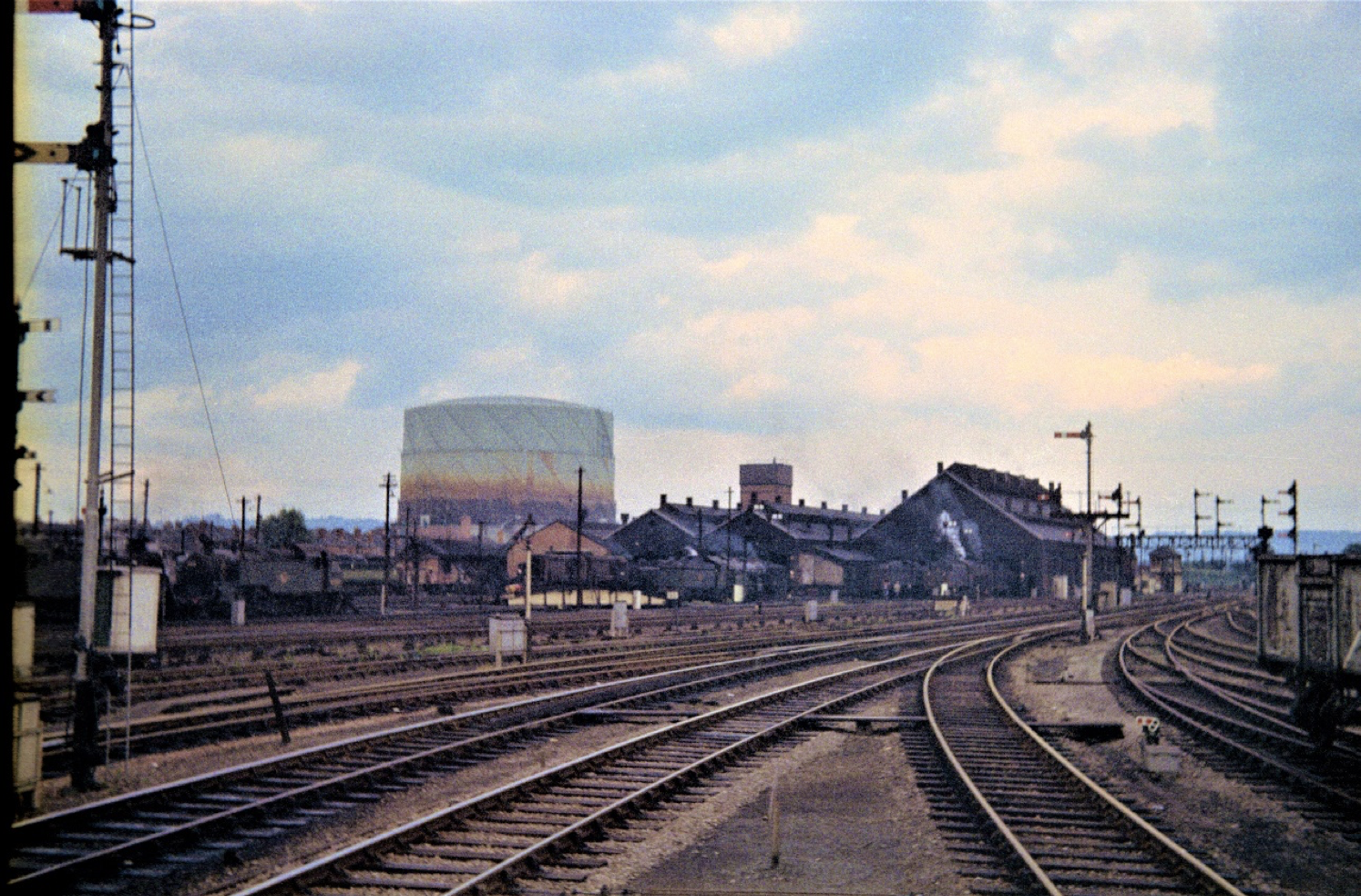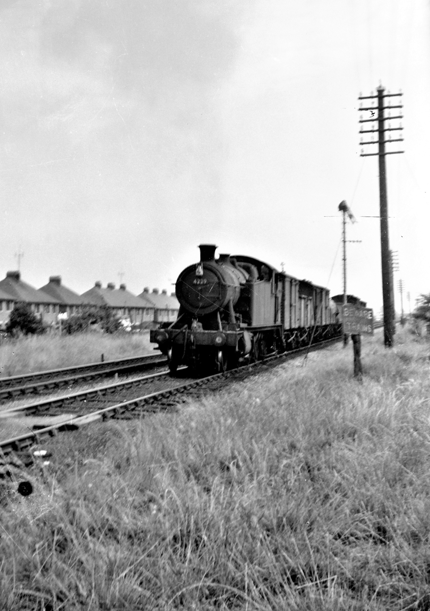1959: Steam’s Indian Summer
Local line closures
In April 1959, the connection between Cheltenham Lansdown and the M&SWJ line was cut. The single through train of the day had been rerouted into St James’ station from 3 November 1958, thereby removing the connection with Midland line expresses from the north. This provided the only opportunity to regularly see a Southern engine in our area. The train arrived at Cheltenham Spa St James from Andover Junction at 10.52am, returning at 1.52pm through to Southampton, and was usually worked by a ‘U’ class 2-6-0 from Eastleigh (71A). Unsurprisingly, the service did not survive long: after lasting for a mere seventy years the line was closed completely from 11 September 1961. One loco from the MSWJR that was absorbed into GW stock survived into BR days. 2-4-0 No. 1336 was built in 1894 only three years after the formation of the M&SWJR. I never saw it and it was withdrawn in 1957.
On 13 July 1959, the Ledbury branch was closed, the last train being hauled by that 85B stalwart, No. 3203. The regular performer on this branch was an ex-GW AEC diesel railcar No. W19W, although No. W20W was also allocated to 85B in early 1959 [February 1956 TI records W19W being reallocated to 85B and then withdrawn, whilst W20W is sent to 85A. However, W19W was certainly withdrawn by February 1960]. The railcars came from and returned to Cheltenham at the end of the day. I particularly remember seeing one of them working the 4.08pm departure from Gloucester to Ledbury on Saturday afternoons. Some members of this class had been originally used on Birmingham – Swansea expresses in the 1930s. The Ledbury branch remained open for goods traffic as far as Dymock to 1964, freight remaining in the hands of Collett 0-6-0s.
The Cinderford branch passenger service had been withdrawn earlier on 3 November 1958. I cannot recall seeing any of the branch trains at Central station and never travelled this branch which left the main South Wales line at Bullo Pill Junction, between Newnham and Awre (for Blakeney).
Two other branches on which I never travelled were the Cirencester and Tetbury branches from Kemble. They were given a new lease of life when the services were handed over to Park Royal rail-buses working from Swindon (W79975 etc.) on 2 February 1959. Although their operation enabled economies to be made, the branches closed five years later, from 6 April 1964 due to the implementation of the cuts identified in the Beeching Plan.
Summer of change
Now, I was using my Brownie box-camera taking 620 film to record local happenings, concentrating particularly on more ancient locomotives such as old Midland 4-4-0s, although the relatively new ‘9Fs’ were also attractive. Midland ‘2P’ No. 40489 was still to be observed on a local service at Gloucester Eastgate on 12 March 1960, although normally carrying out station pilot duties. Unfortunately, it did not survive much longer, being withdrawn in August that year. Gloucester’s last compound, No. 41123 also acted as station pilot, but appeared to assist No. 73142 on the 8.0am Newcastle – Cardiff in August 1959, a regular double-headed turn. However, No. 41123 was withdrawn at the end of the year. Later, on 24 September the newly restored Midland compound, No. 1000, appeared in Gloucester on a special train, and worked through subsequently on a Gloucestershire Railway Society railtour on 27 May 1961. After the demise of the 4-4-0s, Standard ‘4’ 4-6-0s then became the usual Eastgate station pilots.
A further batch of new ‘9Fs’ built at Crewe was also being allocated to WR sheds, including Banbury (84C) and Ebbw Junction (86A). They would eventually take over working the Banbury – South Wales iron ore trains, as Woodford Halse ‘WDs’ were ousted from these duties. From June 1960 these trains were also rerouted onto the Honeybourne route away from the MR line from Broom Junction to Ashchurch. The last of the class, No. 92250, was fitted with a Giesl oblong ejector at the end of 1959, and being allocated to 84C was a regular performer on the South Wales iron ore trains in the early 1960s. Interestingly enough, this locomotive ended its days at 85B, being withdrawn when steam officially ended on the WR on 31 December 1965. Midland Region ‘9Fs’ also continued to put in many appearances on summer Saturday extras in 1959.
In 1959 our family moved to Highworth Road, Tredworth, a good base from which to observe rail activity, being sandwiched between the Midland and Western lines on the south side of the city. I can recall lying in bed in the late evenings and hearing the shunters working at night in the New Yard. They always welcomed in the New Year with a cacophony of whistling. The nearest spotting place to our new home was a foot crossing on the Western line that led from the end of Hartland Road to Northfield Road in the White City. Here it was possible to photograph a variety of interesting services that passed through Gloucester on the avoiding line. Further photographs from this time will be found in Photo Gallery.
Churchward 2-8-0T No. 4229 approaches the Hartland Road foot crossing as it heads from Gloucester South Junction towards Tuffley Junction with a class H freight on 9 July 1959.
Rare visitors at Tuffley Junction
The most significant event of the 1959 summer occurred on 7 June when ‘Royal Scot’ 4-6-0 No. 46114 Coldstream Guardsman worked a 14-coach special (W707) from Rugby to Weston-super-Mare: the first sighting of a ‘Scot’ in Gloucester in our memory, although it is on record that No. 46120 Royal Inniskilling Fusilier appeared in the area in February 1949, and No. 46122 Royal Ulster Rifleman was photographed on 12 Sept 1953 on the 9.45am Bournemouth – Manchester. Later, on 29 October 1959, another ‘Scot’, No. 46137 The Prince of Wales’s Volunteers (South Lancashire) (9A) was recorded working the ECS of the Royal train. This loco was the last ‘Royal Scot’ to be rebuilt, in 1955. Rebuilt ‘Patriot’ No. 45525 Colwyn Bay (8A) also worked the 8.16am Bournemouth – Liverpool on August Bank Holiday. Another rare visitor was ‘Jubilee’ No. 45720 Indomitable (67A) which worked the ‘Devonian’ on 20 July.
‘B1s’ were becoming regular visitors, particularly as several members of the class had been reallocated temporarily to Millhouses (41C). One of their regular turns was the 10.30am Sheffield – Bristol, departing from Gloucester at 2.33pm. Thus No. 61164 was seen at Gloucester on 27 June. I timed a good run behind No. 61318 (40B) on this train one afternoon, covering the journey from Gloucester to Bristol in 45 minutes 30 seconds, gaining 8 minutes on schedule after a late start, with a maximum speed of 80 mph at Coaley Junction. Foreigners from NER sheds included No. 61257 (50B), which reached Bristol during February 1959, No. 61069 (50B) in May, No. 61288 (50A) in June and No. 61198 (50A) in September. Other ‘B1s’ recorded included No. 61083, and No. 61370 working the 7.40am Bristol to Bradford from Gloucester on 7 November.
As 1959 progressed, and the impact of the regional boundary changes of 1958 increased, more exotic ex-LNER locomotives than ‘B1s’ appeared in Gloucester occasionally. On 23 August ‘J39’ No. 64930 was reported on the 4.45pm Bristol – Birmingham, whilst on 11 October No. 64789 was observed on 82E. On 16 November, ‘V2’ 2-6-2 No. 60954 reached Bristol on the 12.48pm from York, which caused much consternation due to its axle-loading. Then on the 21st, ‘K3’ No. 61961 was reported on a southbound freight. Another ‘V2’ No. 60839 was recorded at Bristol on 11 December, despite the class being officially banned south of Birmingham. However, there are no records of any ex-ER Pacific ever travelling beyond Worcester, although they did work Bristol expresses as far as Birmingham on occasion, despite theoretically being banned from working south of Sheffield. A fuller list of Eastern locos noted in Gloucester can be found at Data Records – Eastern Visitors.
‘9Fs’ also put in several appearances on summer Saturday extras, alongside ‘B1s’ and Stanier ‘Crabs’ (two of which worked to Bath over the summer Bank Holiday).

